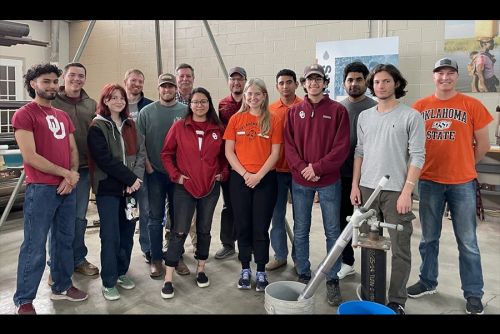It was a Saturday morning in the Oklahoma City office of Water4, whose mission it is to eradicate the world’s water crisis. Gathered here were students donning orange and crimson who enrolled in a spring semester course titled Water Technologies for Emerging Regions.
Students from the University of Oklahoma and Oklahoma State University are part of a hands-on demonstration by OU Civil Engineering and Environmental Science alumni Philip Deal and the staff at Water4 in Oklahoma City.
Two students face each other with the 15’ drill stem pipe between them. Two separate horizontal pipes intersect the vertical pipe attached to the auger can that penetrates and captures the soil. Each person grasps the horizontal pipes: left hands on the inside, right hands on the outside. In a true sense of rhythm and collaboration, they turn, pull and push in symmetry, pushing the auger can inch by inch into the soil until it is filled, at which point they pull it out of the hole, deposit the soil nearby and repeat the process until they penetrate the water table.
The class met three days a week on their respective campuses and simultaneously on Zoom, bringing everyone together. Students heard from various experts in the field of water technology throughout the semester. They met in person three times to participate in field studies, first in Stillwater to build biosand filters, then in Edmond to repair a rainwater harvesting system that had been vandalized, and finally at Water4, where they learned how to drill a hand well.
As a final project, students in the class formed small groups to research a selected region’s water needs, create a timeline to estimate duration of travel and generate a budget to estimate cost of the entire project. The teams presented to invited professors and a dean about their projects that included saltwater intrusion in Bangladesh, uranium and arsenic in drinking water at the Pine Ridge Reservation in South Dakota and onsite drinking water quality in Haiti. This team exercise further demonstrated the breadth of the topics and geographies covered by the class.
“Coming together for the common good is what collaboration is all about. I am so impressed by these students. Embracing our differences and discovering solutions together enhances our impact as employees, engineers and citizens of the world,” said John Klier, dean of the OU Gallogly College of Engineering.
The collaborative class was inspired and co-taught by Jason Vogel, OU professor in the School of Civil Engineering and Environmental Science and director of the Oklahoma Water Survey, together with Paul Weckler, professor in the Department of Biosystems and Agricultural Engineering, and Greg Wilber, associate professor of Environmental Engineering & Water Resources, both at Oklahoma State University.
OU’s recently retired professor in the School of Civil Engineering and Environmental Science and founder and director of the OU WaTER Center David Sabatini asked Vogel to take over the class. Vogel’s connections with Weckler and Wilber and others at OSU from his time as a doctoral student and faculty member, served as an impetus to offer this unique course that Vogel plans to offer again in the spring of 2024.
One participant was Sloane Johnston, a senior studying environmental engineering at OSU who is a member of the student organization Engineers Without Borders because it allows her to merge her passion for math and science to benefit others. She learned about the course from her adviser, Greg Wilbur.
“I see this class as a way to learn how to give back and serve in different capacities to benefit those who need help to access clean drinking water,” Johnston said.
Anthony Gallegos Garcia, then a senior studying environmental engineering at OU, sees himself working in the water sector helping emerging regions solve issues of water scarcity.
“In this class you learn a lot about issues all over the world, but I’ve noticed in my own country – Mexico – we have our own issues and very low resources in certain communities that don’t have access to clean water or water distribution systems,” Garcia said.
Students taking the Water Technologies for Emerging Regions class have been inspired by what they’ve learned, and many have hopes of working in the field, bringing solutions and clean water to communities around the world.
Begun in 2006, the OU class introduced students to water and sanitation challenges in under-resourced regions of developing countries.
“What an amazing opportunity for these students to collaborate with their sister institution while learning to provide life-saving water and sanitation to resource challenged citizens, both international and domestic!” David Sabatini exclaimed. “I am so proud of Jason, Paul and Greg for their pioneering efforts.”
Learn more about OU Engineering.
By Karen A. Kelly, Gallogly College of Engineering


